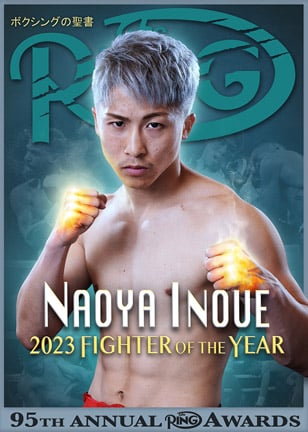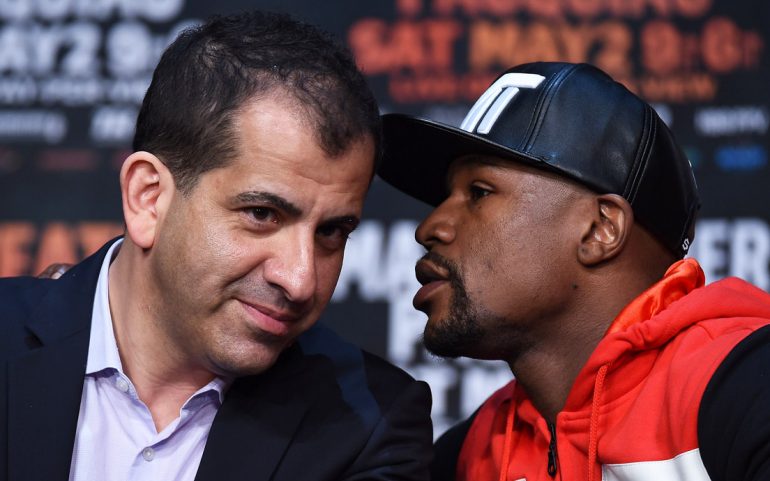
Labor of Love
Stephen Espinoza (left) hatched the idea of a landmark partnership between Showtime and Floyd Mayweather. (Photo by Ethan Miller/Getty Images)
STEPHEN ESPINOZA LOOKS BACK ON THE LEGACY OF SHOWTIME BOXING
Jay Larkin scooted out of the Atlantic City Convention Hall arena as quickly as his short legs would take him. The Showtime executive was hurrying to the catering tent on a Friday night, June 1, 1990, after heavyweight contender Evander Holyfield had swept away Seamus McDonagh in four rounds. Larkin had a bottle of champagne tucked away for a special celebration: Showtime’s first in-house boxing production. The subscription network had relied on outside production companies during the first four years of its boxing broadcasts. Larkin toasted the event, “Here’s to the first one. Let’s hope for many more.”
There were many, many more to come.
Showtime forged onward until the eve of the end came on a Friday night, December 15, 2023, in a somber hotel ballroom in Minneapolis, Minnesota. It was cause for another champagne toast, where a gathering of everyone who helped make Showtime Boxing a success took time to talk and reminisce about a legacy that lasted 37 years, covering nearly 750 live boxing events and 2,000 bouts.
In the eye of the occasion stood Stephen Espinoza, President of Showtime Sports, who would get lost the first two months with the network before he found his own office. Eventually, Espinoza discovered where to go, and eventually took Larkin’s creation to new heights, ultimately exceeding HBO’s rival boxing programming. Larkin himself passed away on August 9, 2010.
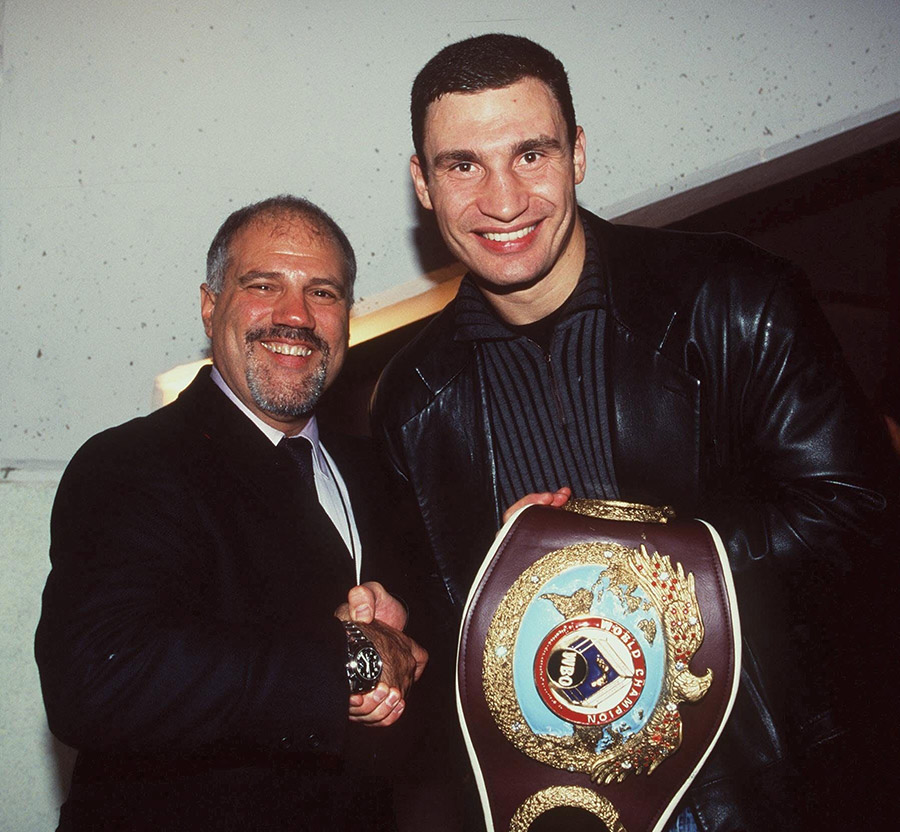
October 1999: Jay Larkin in Germany with Vitali Klitschko, who made his U.S. TV debut on Showtime. (Photo by Marcus Brandt/Bongarts/Getty Images)
The Showtime Boxing curtain came down at the end of arguably its greatest year of televising the sport, finishing with super middleweight contender David Morrell Jr.’s two-round demolition of Sena Agbeko at The Armory in Minneapolis.
By December, news of the program’s demise was two months old. Paramount Global, Showtime’s parent company, announced in a mid-October statement that it was ending the Showtime Sports department altogether.
Like HBO Boxing, there will never be an entity like it again. Showtime Boxing encompassed a group of ardent, talented people who loved and were immersed in boxing – a rarity by contemporary television standards. And it involved a leader, Espinoza, who had a passion for the product outside the dollars and cents it produced.
“I strongly believe Showtime Boxing will be remembered as one of the two pillars that carried the sport of boxing and elevated the sport for nearly four decades,” said Espinoza, who completed his 12th year at the network in November 2023. “I don’t see how it could be any other way. You look at every objective measure, whether it was the amount of fights, the quality of fights, the number of historic events, the number of superstar and hall of fame fighters we showed – boxing would not be where it is today without the efforts of Showtime and all those individuals who made up Showtime over the last 37 years.
“We handled all of our events with diligence and care, whether it was Floyd Mayweather-Manny Pacquiao or an opening bout on ShoBox: The New Generation.”
“As a network, I think we’ll be remembered as being objective, fair, fighter-first, committed to elevating the fights and the fighters, above all else, and a tremendous respect within Showtime for fighters at all levels. We handled all of our events with diligence and care, whether it was Floyd Mayweather-Manny Pacquiao or an opening bout on ShoBox: The New Generation. There was a commitment to excellence all the way through.”
Showtime started with a bang, on March 10, 1986, when middleweight champion Marvelous Marvin Hagler defeated John Mugabi by knockout at the outdoor arena at Caesars Palace in Las Vegas. Showtime then played the arduous kid brother to HBO, for years playing catch-up to the rival subscription cable network’s huge boxing budget. The first shift came in 1990 when Showtime signed Mike Tyson, who’d originally gone to HBO in the late ’80s. The second shift occurred when Espinoza signed Mayweather to a six-fight deal in 2013. That evolved into Mayweather-Canelo Alvarez in 2013 (the third-highest grossing PPV event in TV history, with 2.2 million buys), which was surpassed by the long-awaited Mayweather-Pacquiao duel in 2015 (co-produced with HBO, it was the largest PPV with 4.6 million domestic buys and the highest-grossing event in PPV TV history) and Mayweather’s beating of MMA star Conor McGregor in December 2017 (the second-largest PPV on record, with 4.3 million PPV domestic buys, and the second-highest grossing PPV event in history).
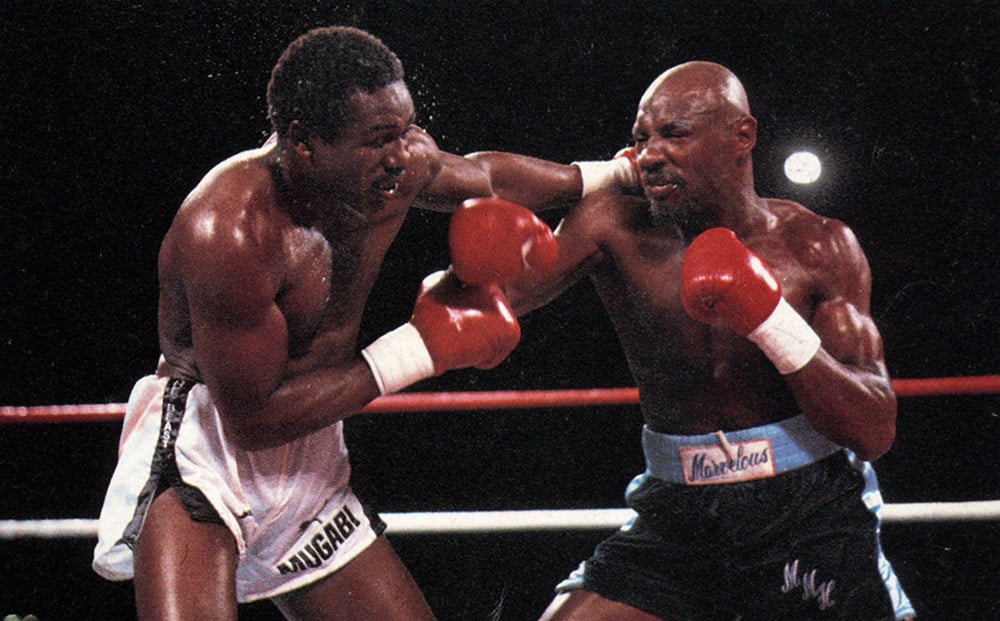
Hagler (right) vs. Mugabi was an early hit for Showtime. (Photo: The Ring Magazine)
“There is a tendency to not appreciate something until it is gone,” Espinoza said. “The last show was very emotional for a wide range of people. There is a healthy number of people who were here at the beginning, or close to the beginning. That says something about how well the company treated its people, which is one element, and the other element is nothing is successful without people that are passionate and committed to making personal sacrifices. They invested their own time and resources in creating Showtime Sports. I know it sounds like a cliché, but it was not just a job, it was a passion to many people along the way. I think that is what made us special.

Andre Ward outpointed Edison Miranda on ShoBox, his first real test in what would be a Hall of Fame career. (Photo by Jed Jacobsohn/Getty Images)
“There was disappointment and a sense of personal loss when the word came down that [Showtime Sports] was being taken away. I’m sure there will not be another 37- or 40-year partner to boxing like Showtime Sports was. You have to look at where we are today, with streaming and how the rate of change has accelerated so rapidly over the last 10 years that no one will have 40 years of stability moving forward. Business models are springing up overnight. But we had to overcome obstacles, and we kept delivering. To see what we did, with what we were given, it’s something I take immense pride in.”
Espinoza openly admits he was fortunate to inherit the star-studded production team of Showtime Senior Vice President and Executive Producer David Dinkins Jr., Showtime Senior Vice President Gordon Hall and a broadcast team that included hall of famers Jim Gray, Al Bernstein and Steve Farhood. Showtime Vice President of Sports & Event Marketing Sheila Mills produced imaginative ways to sell the fights, and public relations guru Chris DeBlasio kept Espinoza apprised of what the boxing media was saying.
Until the waning months of 2023, Espinoza said keeping boxing on Showtime was not a fight. He had the complete support of the executive level under longtime Showtime CEO Matt Blank, until his departure in 2015, and with Blank’s successor, David Nevins. In the end, Espinoza said, it was a simple process of Paramount Global’s transformation to the pressures of the ever-changing media landscape in America today. Paramount had not been immune to those changes.
The senior level of Paramount leadership felt a new strategy had to be implemented for Showtime Sports as a whole. Espinoza personally got the message on a relatively brief call in late September 2023. It was a cut-and-dried conversation. Espinoza had suspicions something was coming. Paramount was making cuts and selling properties. Showtime was making cuts.
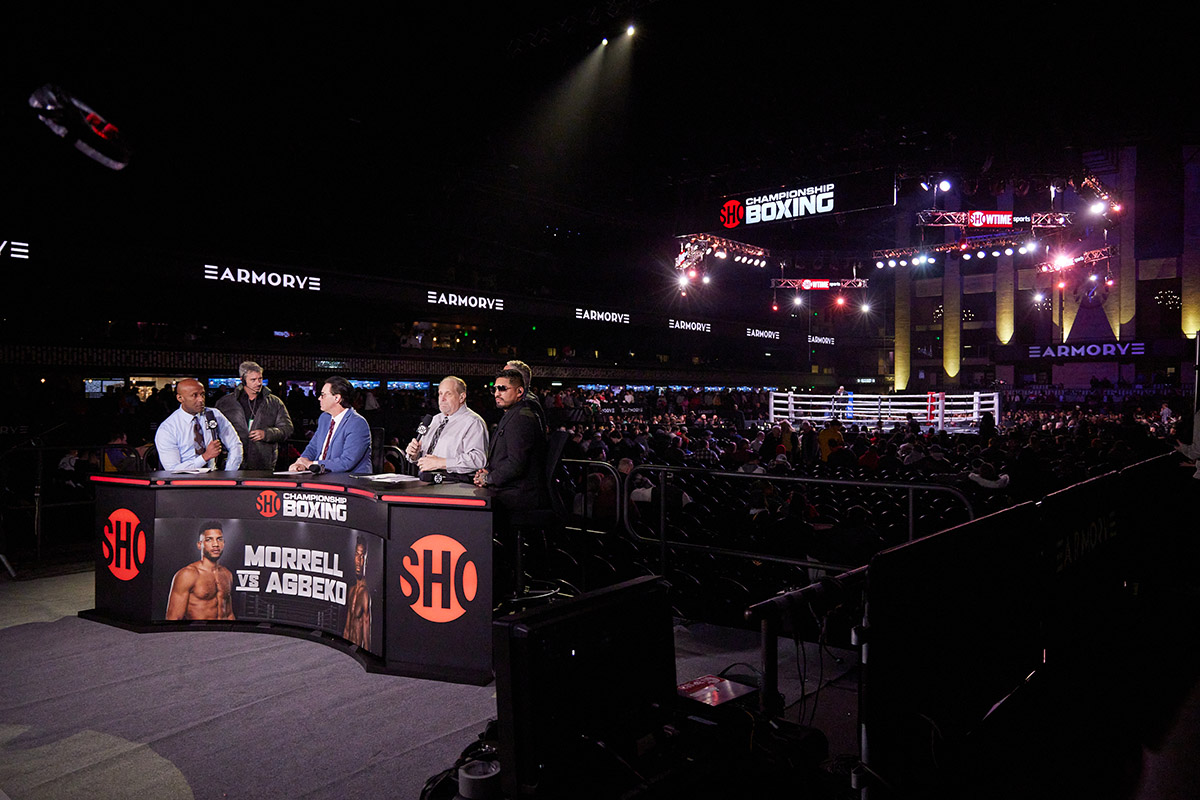
Showtime’s final boxing broadcast featured David Morrell Jr. vs. Sena Agbeko at The Armory in Minneapolis. (Photo by Adam Bettcher/Getty Images)
Larkin liked the glitz of boxing. Ken Hershman, Larkin’s successor, was more behind-the-scenes but would be the driving force behind the groundbreaking Super Six Series tournaments, and Espinoza arrived with a wealth of boxing knowledge and possessed a genuine ardor for the sport.
“We were definitely Avis to HBO’s Hertz for a while there, in comparison to HBO’s budget,” said Hall, “but I do know everyone in our group was really passionate about boxing, and that is the one big thing Stephen brought – he sincerely loves boxing.
“When HBO was still in business and still thriving, we were competitive, and there were certain years we surpassed them. We helped elevate Tyson and Mayweather. If this was going to be Showtime Boxing’s proving year for Paramount, we passed it with flying colors. We produced big fights, with big audiences. We just didn’t support fights; we supported the sport of boxing. It was more than covering the fights for us. It was covering boxing. It is absolutely a legacy I leave enormously proud of. I was there when Jay popped the cork of that champagne bottle in Atlantic City. We didn’t know how long it would last.”
Dinkins Jr. quickly noticed Espinoza’s commitment.
“Remember, this was all new to Stephen, even though he had been around boxing for a while, and his original perspective was through his association with HBO without knowing what we had at Showtime,” Dinkins said. “He came quickly to appreciate the culture at Showtime. He sensed cooperation and noticed it was not the snake pit a lot of other places were. Stephen was welcomed immediately. He trusted us, and we trusted him. What made us special from the other networks was the commitment and love for boxing that ran through the staff.
“There was a joy we had in the process and the exhilaration of being around a big fight. It was not treated as a job. We all loved what we were doing. We all know people who work a job and are exceptionally good at their jobs and they really do not like what they are doing. To a person, the people we had at Showtime loved boxing and the culture of boxing. Our legacy internally and externally will be that passion we brought to the dance.”
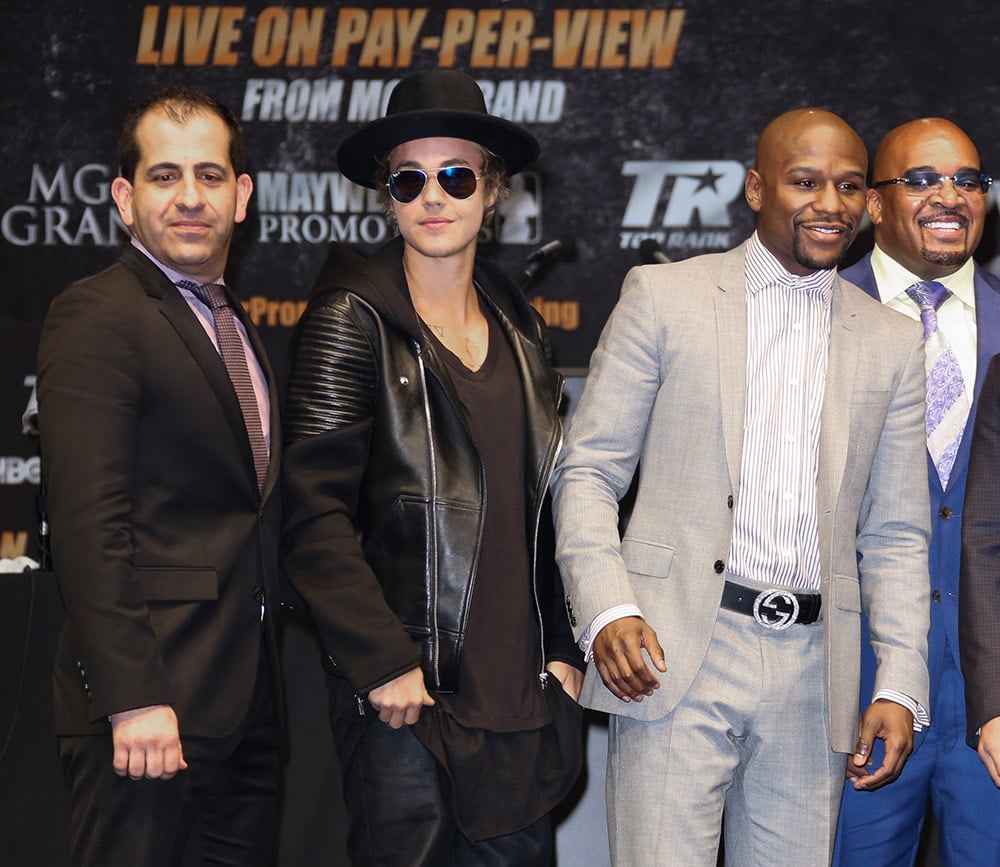
Espinoza made true Beliebers of everyone when Mayweather-Pacquiao became the most successful pay-per-view in history. (Photo by Paul Archuleta/FilmMagic)
One of Espinoza’s lasting memories is of arriving at Showtime’s 16th floor offices for the first time in November 2011. He whimsically recalls his early dilemma.
“I didn’t know where my office was – that was the level of uncertainty I was dealing with,” he said, laughing. “I came from California, where I lived all my life with a few bags packed. I had no coat. And I was dealing every day with this. Everywhere I worked at was small. At Showtime, there are big floors and they’re rectangular, so I did not know where my corner office was. I knew I had a corner office. There were times I would wander all four corner offices. I could never get it straight. (laughs) It may have taken me six, maybe eight weeks to find out how to get to my office.
“Sometimes people would notice me wandering around and they would ask, ‘Do you know where you’re going?’ and I would say, ‘No.’ Other times I would openly ask where my office was. Within a couple of weeks, everyone knew me more than I knew where my office was.” (laughs)
A year later, calling from his office, Espinoza arranged a meeting in Los Angeles with Les Moonves, then CEO of CBS, which at the time was Showtime’s parent company, long before the merger that created Paramount Global. Espinoza showed up bare bones, with no PowerPoint presentation, no financial statements, just a wacky idea in his head. He presented Moonves with the notion of signing Mayweather to a $300 million, six-fight deal that was at the time the richest contract in professional sports.
“Okay, I’ll make you a deal,” Moonves told Espinoza. “If this works, it will be your baby. I will not take credit for it, no one else will take credit for it. This will be yours to run. But if it doesn’t work, that’s on you, too.”
It worked out well for someone who was wandering around a year earlier.

Joseph Santoliquito is an award-winning sportswriter who was inducted into the Atlantic City Boxing Hall of Fame in 2023. He has contributed to Ring Magazine/RingTV.com since October 1997 and is the president of the Boxing Writers Association of America.

